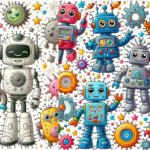When it comes to captivating storytelling, there’s something uniquely compelling about Your Topics | Multiple stories. Whether through parallel narratives, shifting perspectives, or interconnected plotlines, multiple stories can elevate a narrative to new heights. In this article, we’ll explore how multiple stories work in storytelling, their thematic impact, and how this storytelling technique can benefit your writing or creative projects. Let’s dive deep into the world of interwoven narratives and explore the power of having multiple stories within one cohesive narrative.
- Types of Your Topics | Multiple stories
- Thematic Impact of Your Topics | Multiple stories: Adding Depth and Complexity
- Narrative Techniques Used in Your Topics | Multiple stories: How Writers Keep It Engaging
- How Your Topics | Multiple stories Engage and Affect Viewers
- Challenges in Writing Multiple Stories: The Art of Balancing Narrative Threads
- Conclusion:
- Invest1Now.com Cryptocurrency: A Complete Guide for Smart Investors
- How Neglected Exteriors Can Affect the Lifespan of Your Building
- What is Harmonicode? An Overview of Harmonicode.com Platform
- Why HarmoniCode Gaming Is The Next Big Thing in Music-Based
- Crypto30x.com TNT Perfect For Crypto Trading with Crypto30x
- What is Your Topics | Multiple stories Complete Guideline?
Types of Your Topics | Multiple stories
When you think of multiple stories, you might imagine different characters or events occurring simultaneously. But in storytelling, multiple stories can take several forms. Each approach serves a unique purpose and can deeply impact the audience’s experience. Let’s explore the most common types:
1. Parallel Narratives: Creating Your Topics | Multiple Storylines That Run Side by Side
Parallel narratives involve two or more storylines happening at the same time, often exploring different themes but tied together by a common thread. These stories usually mirror or contrast one another, creating a sense of balance and interconnectedness.
Example: In David Mitchell’s Cloud Atlas, multiple stories unfold across different time periods, each one revealing elements that influence the others. The juxtaposition of these parallel stories adds a layer of complexity that amplifies the overall narrative.
2. Interwoven Narratives: Weaving Stories Into One Unified Experience
Interwoven narratives, on the other hand, focus on stories that overlap or converge. Characters or events from one narrative thread influence others, creating a sense of cohesion and interconnectedness.
Example: The movie Crash brilliantly uses interwoven narratives to explore themes of racism, identity, and human connection. Each character’s story touches upon the others, creating a tapestry of diverse experiences that enhance the film’s message.
3. Multiple Perspectives on the Same Event: A Richer View of One Story
One of the most powerful techniques is presenting the same event from different characters’ perspectives. This allows the audience to see varying emotions, thoughts, and motivations, offering a more nuanced understanding of the event.
Example: In William Faulkner’s As I Lay Dying, each character shares their own viewpoint of the same journey, creating a fragmented yet powerful narrative that deepens the emotional resonance of the story.
4. Anthologies and Collections: Diverse Stories in One Cohesive Work
Anthologies or collections often feature multiple standalone stories that are thematically connected. These stories may not overlap in terms of plot, but they create a unified experience through shared themes, settings, or character types.
Example: The Canterbury Tales by Geoffrey Chaucer is an anthology of stories told by different characters on a pilgrimage. Modern collections, like The Secret Lives of Church Ladies by Deesha Philyaw, also showcase interconnected short stories that reveal unique perspectives on identity and culture.
Thematic Impact of Your Topics | Multiple stories: Adding Depth and Complexity
One of the greatest strengths of incorporating multiple stories into a narrative is the thematic depth it provides. Here’s how different storylines enhance the overall narrative:
Enhanced Complexity and Depth: A Bigger Picture Unfolds
Your Topics | Multiple stories allow for a layered, multifaceted approach to storytelling. Each narrative adds depth, and as the stories intertwine, they build toward a grander theme or message. This complexity engages the audience and keeps them coming back for more.
Reflection of Reality: Life’s Multi-Dimensional Nature
Real life is never one-dimensional, and Your Topics | Multiple stories mirror that. By weaving together contrasting or similar experiences, storytellers reflect the chaotic, multifaceted nature of the world around us. These stories give the audience a deeper understanding of human emotions, relationships, and conflict.
Exploring Contrasting Themes: Love, Loss, and Everything In Between
By offering multiple storylines, you can juxtapose contrasting themes like love and loss, happiness and sorrow, or hope and despair. This contrast can create an emotional rollercoaster, making your story more dynamic and impactful.
Narrative Techniques Used in Your Topics | Multiple stories: How Writers Keep It Engaging
Mastering the art of Your Topics | Multiple stories requires the use of several narrative techniques. Let’s break down some of the most effective ones used by seasoned storytellers:
1. Non-Linear Storytelling: Jumping Between Time Periods and Locations
Non-linear storytelling is a popular technique in multiple story narratives, where the timeline jumps between different periods, locations, or perspectives. This keeps the audience engaged and intrigued as they work to piece together the narrative puzzle.
Example: Movies like Pulp Fiction use non-linear storytelling to tell multiple stories in a non-sequential order, creating suspense and curiosity about how everything will connect in the end.
2. Character Arcs and Development: Deeper Exploration Across Stories
Multiple stories provide ample room for developing complex characters. Writers can explore how characters evolve across different narratives, giving each character their own arc within the larger context.
This depth makes the characters more relatable and allows for a richer, more immersive experience for the audience.
3. Symbolism Across Stories: Creating Connections Through Shared Motifs
Symbolism can tie multiple stories together, even when they seem unrelated at first glance. A recurring symbol, object, or theme can appear across the different narratives, subtly creating a connection and reinforcing the overall message.
Example: In The Hours by Michael Cunningham, the recurring motif of Virginia Woolf’s novel Mrs. Dalloway acts as a bridge between the different storylines, linking the characters’ lives and struggles.
How Your Topics | Multiple stories Engage and Affect Viewers
How do Your Topics | Multiple stories affect the audience? Let’s explore how this storytelling technique enhances the viewer’s experience:
From Confusion to Clarity: The Journey of Unfolding Narratives
At first, multiple stories can seem disorienting. However, as the narratives start to converge, the audience experiences a satisfying sense of clarity. This emotional payoff keeps audiences engaged, rewarding them for sticking with the story.
Emotional Impact: Tapping into Different Aspects of the Human Condition
Multiple stories allow the audience to explore different emotional landscapes. By presenting contrasting or overlapping narratives, storytellers can create a rich emotional tapestry that resonates deeply with viewers or readers.
Engagement: Inviting the Audience to Piece Together the Puzzle
Rather than simply presenting a single, straightforward plot, multiple stories challenge the audience to engage actively with the narrative. The complexity invites the audience to connect dots, uncover hidden meanings, and explore different viewpoints, making the experience more rewarding.
Challenges in Writing Multiple Stories: The Art of Balancing Narrative Threads
Writing multiple stories is not without its challenges. Here are some key obstacles to keep in mind:
1. Balancing the Different Storylines
One of the biggest challenges when writing multiple stories is balance. You need to ensure that no single storyline overshadows the others. Each narrative should contribute equally to the overall theme and progression of the work.
2. Maintaining Clarity for the Audience
While complexity can add depth, it’s essential not to confuse your audience. Each narrative should be distinct and clear, so the audience can easily follow along without getting lost.
3. Developing Unique Voices for Each Narrative
To avoid redundancy, each story should have its own unique voice. Characters, settings, and plotlines should feel distinct, creating a diverse but cohesive whole.
Conclusion:
Incorporating Your Topics | Multiple stories into your narrative can significantly enhance its depth, engagement, and emotional impact. Whether through parallel narratives, interwoven stories, or Your Topics | Multiple stories, each story adds a layer of meaning that enriches the entire experience.
By mastering techniques like non-linear storytelling, character arcs, and symbolism, you can create a truly compelling narrative that keeps your audience hooked from beginning to end.
So, if you’re a writer or creator looking to Your Topics | Multiple stories, don’t shy away from using Your Topics | Multiple stories. Embrace the power of interconnected narratives, and watch as your work reaches new heights of creativity and emotional resonance.
Invest1Now.com Cryptocurrency: A Complete Guide for Smart Investors
Invest1Now.com has emerged as one of the most popular platforms for crypto investors seeking simplicity, security, and reliability. But what…
How Neglected Exteriors Can Affect the Lifespan of Your Building
Exterior walls are the first barrier that protects a building from weather and environmental factors. It’s essential to maintain your…
What is Harmonicode? An Overview of Harmonicode.com Platform
Harmonicode is quickly becoming a household name in the worlds of gaming and sports Model of Harmonicode in Sports,…
Why HarmoniCode Gaming Is The Next Big Thing in Music-Based
HarmoniCode gaming represents a revolutionary fusion where player actions synchronize perfectly with musical patterns, creating an entirely new way to…
Crypto30x.com TNT Perfect For Crypto Trading with Crypto30x
What is Crypto30x.com TNT? When diving into the world of cryptocurrency, choosing the right platform is crucial. That’s where Crypto30x.com TNT…
What is Your Topics | Multiple stories Complete Guideline?
When it comes to captivating storytelling, there’s something uniquely compelling about Your Topics | Multiple stories. Whether through parallel narratives,…







